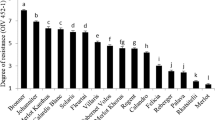Abstract
The susceptibility of apple leaves toVenturia inaequalis was investigated by assessing disease on individual leaves of seedlings and labelled shoots of orchard trees. Four sets (A-D) of potted seedlings of cv. ‘Golden Delicious’, which had been grown in a glasshouse, each with approximately 30 mature leaves, were exposed to a high-inoculum orchard. Sets A and B were exposed after each other for 47 and 42 days, respectively. As a result of the six and three infection periods during exposure, 94% and 81%, respectively of the seedling shoot tips in set A and set B became infected. However, due to ontogenetic resistance, disease incidence was low in both sets on leaves which were fully expanded at the beginning of exposure. Set C was exposed during both periods (89 days) in which sets A and B were exposed. Not only were all the seedling shoot tips in set C infected, but also — due to the loss of ontogenetic resistance — nearly all of the mature leaves. Ontogenetic resistance was also lost in set D, which was exposed for 57 days at the end of the growing season. The symptoms on fully expanded leaves on plants in sets C and D were typical and similar to those on young leaves. A time course symptom assessment was performed on leaves which had developed early in the season on labelled, field-grown shoots of cv. ‘Golden Delicious’ trees. A steady increase of disease incidence was detected, which could not only have resulted from infections followed by extended incubation periods. In addition to the increase of typical lesions on both leaf surfaces, there was also an abundance of diffuse mycelial development on the lower surfaces of the leaves of the field-grown trees.
Similar content being viewed by others
References
Anagnostakis SL and Aylor DE (1991) Efficiency of ascospores ofVenturia inaequalis in production scab lesions on apple leaves. Plant Dis 75: 918–920
Chevalier M, Lespinasse Y and Renaudin S (1991) A microscopic study of the different classes of symptoms coded by the Vf gene in apple for resistance to scab (Venturia inaequalis). Plant Pathol 40: 249–256
Gessler C and Stumm D (1984) Infection and stroma formation byVenturia inaequalis on apple leaves with different degrees of susceptibility to scab. J Phytopath 110: 119–126
Keitt GW and Jones LK (1926) Studies of the epidemiology and control of apple scab. Bulll Wis Agric Exp Stn 73
Kirkham DS and Hignett RC (1973) Control of the vertical distribution of apple scab disease on shoots of the apple rootstock MM 109. In: Byrde RJW and Cutting CV (eds) Fungal Pathogenicity and the Plant's Response (pp 56–66). Academic Press, London
Kohl R and Kollar A (1994) Impairment of ontogenetic resistance of apple againstVenturia inaequalis. Norwegian Journal of Agricultural Sciences. Supp No 17: 399–402
MacHardy WE and Gadoury DM (1989) A revision of Mills's criteria for predicting apple scab infection periods. Phytopathology 79: 304–310
Mills WD (1944) Efficient use of sulfur dusts and sprays during rain to control apple scab. Cornell Ext Bull 630, 4 p
Moore MH (1964) Glasshouse experiments on apple scab. I. Foliage infection in relation to wet and dry periods. Ann Appl Biol 53: 423–435
Schwabe WFS (1979) Changes in the scab susceptibility of apple leaves as influenced by age. Phytophylactica 11: 53–56
Schwabe WFS (1980) Wetting and temperature requirements for apple leaf infection byVenturia inaequalis in South Africa. Phytophylactica 12: 69–80
Schwabe WFS (1982) Wetting and temperature requirements for infection of mature apples byVenturia inaequalis in South Africa. Ann Appl Biol 100: 415–423
Schwabe WFS, Jones AL and Jonker JP (1984) Changes in the susceptibility of developing apple fruit toVenturia inaequalis. Phytopathology 74: 118–121
Sutton TB, Jones AL and Nelson LA (1976) Factors affecting dispersal of conidia of the apple scab fungus. Phytopathology 66: 1313–1317
Tomerlin JR and Jones AL (1983) Development of apple scab on fruit in the orchard and during cold storage. Plant Dis 67: 147–150
Author information
Authors and Affiliations
Rights and permissions
About this article
Cite this article
Kollar, A. Evidence for loss of ontogenetic resistance of apple leaves againstVenturia inaequalis . Eur J Plant Pathol 102, 773–778 (1996). https://doi.org/10.1007/BF01877152
Accepted:
Issue Date:
DOI: https://doi.org/10.1007/BF01877152




